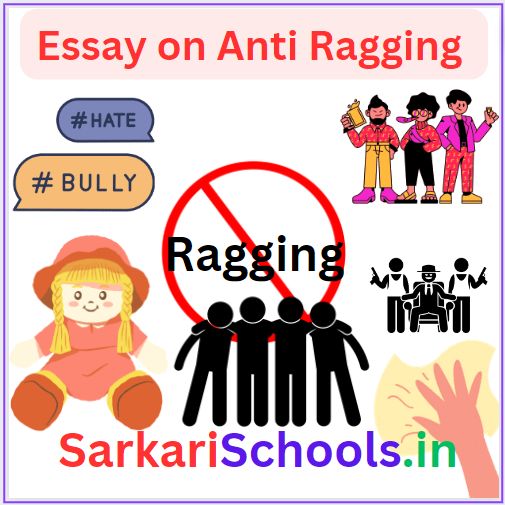Essay on Anti Ragging in English Explore a comprehensive essay on the anti-ragging movement, its significance, recent data highlighting the urgency, government initiatives to curb ragging, and the crucial role of awareness, policies, and support in eradicating this harmful practice from educational institutions.
Ragging is very sensitive matter don’t do ever. My post is just an educational post for more information contact your college , university or Govt. official website
Table of Contents

Essay on Anti Ragging in English
What is Ragging
In English, “ragging” refers to the practice of subjecting newcomers or junior students to various forms of humiliation, harassment, and abuse by their seniors, often within educational institutions. It can include activities that are intended to be playful or bonding but can quickly escalate into acts that are emotionally or physically harmful to the victims. Ragging is widely recognized as a harmful and degrading practice that can have serious negative effects on the mental and emotional well-being of the individuals subjected to it.
In simple words, ragging means when older students in schools or colleges tease, bother, or even hurt the new or younger students. It’s like bullying, but it happens mostly in educational places. It’s a bad thing because it makes the new students feel really bad and scared. We should all work together to stop ragging and be kind to each other.
What is Anti Ragging
Anti-ragging refers to efforts and actions taken to prevent and stop the practice of ragging in educational institutions. It involves creating rules, policies, and awareness campaigns to discourage and eliminate any form of teasing, bullying, or harm inflicted on new or younger students by their seniors. The goal of anti-ragging measures is to ensure a safe and respectful environment for all students, where everyone can learn and grow without fear or harm.
Anti Ragging Form
| Affidavit Registration Form For Affiliated Colleges |
| Anti Ragging Form UNDERTAKING DOCUMENT |
| How To Fill An Online Anti Ragging Undertaking |
| Anti Ragging Affidavit Download |
Anti Ragging Helpline
| National Anti-Ragging Helpline Phone No -: 1800-180-5522 Email -: helpline@antiragging.in Monitoring Agency Centre for Youth (C4Y) New Delhi – 110068 Phone No -: 91-11416 19005 Email -: antiragging@c4yindia.org |
Type of Ragging
Ragging can take various forms, ranging from seemingly harmless pranks to more serious and harmful actions. Here are some types of ragging:
- Verbal Abuse: Mocking, insulting, or using hurtful language to demean or humiliate new students.
- Physical Harassment: Physically harming or subjecting new students to uncomfortable or degrading physical actions.
- Forced Activities: Compelling new students to perform embarrassing or uncomfortable tasks, often against their will.
- Isolation or Exclusion: Excluding new students from group activities or intentionally making them feel left out.
- Bullying: Repeatedly targeting and intimidating new students, causing emotional distress.
- Cyber Ragging: Using digital platforms to harass or spread false rumors about new students.
- Sexual Harassment: Subjecting new students to unwanted sexual advances, comments, or actions.
- Psychological Torture: Using psychological tactics to mentally torment and distress new students.
- Mental Agony: Creating situations that cause emotional stress, anxiety, and mental suffering.
- Financial Exploitation: Forcing new students to provide money or items against their will.
- Threats and Blackmail: Using threats or blackmail to control or manipulate new students.
- Mock Interviews or Tests: Conducting fake interviews or tests to embarrass or demoralize new students.
It’s important to note that any form of ragging, regardless of how mild it may seem, can have negative and lasting effects on the victims. Educational institutions and society as a whole should work together to prevent and eliminate ragging in all its forms.
Reasons of Ragging
Ragging, or the practice of subjecting new or junior students to harassment and humiliation by their seniors, can have various underlying reasons, although none of them justify the harmful behavior. Some potential reasons for ragging include:
- Hierarchy and Power Dynamics: Seniors may feel a sense of superiority and use ragging to establish their dominance over new students, driven by the hierarchical structure of educational institutions.
- Peer Pressure and Conformity: Seniors who themselves were subjected to ragging may perpetuate the practice to fit in with their peers or to continue the tradition.
- Lack of Maturity: Some seniors might not fully grasp the emotional and psychological impact of their actions, thinking that ragging is just a way to have fun or initiate newcomers.
- Desire for Bonding: Seniors may believe that ragging is a means to create a bond among students, even though the methods used can be harmful.
- Tradition and Social Norms: In some cases, ragging may be seen as a longstanding tradition or a rite of passage, making it difficult to break free from such cultural norms.
- Misguided Sense of Camaraderie: Seniors may wrongly believe that ragging helps build unity and camaraderie among students, despite its negative consequences.
- Lack of Awareness: Some students might not be aware of the emotional and psychological toll that ragging can take on their victims.
- Entertainment and Amusement: Ragging might be seen as a form of entertainment for some students, without fully considering the feelings and well-being of the victims.
- Inadequate Guidance: Lack of proper guidance and supervision from educational institutions can contribute to the perpetuation of ragging.
- Need for Attention: Seniors seeking attention or a sense of importance may resort to ragging to gain recognition.
It’s important to recognize that these reasons do not justify ragging in any way. Ragging is a harmful practice that can have serious negative effects on the victims and the overall atmosphere within educational institutions. Efforts should be focused on promoting empathy, respect, and a positive environment that fosters healthy relationships among all students.
Recent Statistics and Government’s Endeavors to Combat Ragging
New data has brought to light a distressing reality: between the years 2014 and 2015, a heartbreaking total of 15 students took their own lives due to the anguish caused by ragging. This serves as a stark reminder of the urgent need to address this deeply troubling issue.
Between June 2009 and September 2014, specific states have borne witness to alarming numbers of ragging cases. These states include Odisha, with a troubling count of 266 cases, followed closely by Madhya Pradesh with 263 cases, Maharashtra with 150, Tamil Nadu with 143, Rajasthan with 142, Bihar with 132, and Delhi reporting 57 cases.
Taking a step back, the year 1997 marked a significant milestone when the state of Tamil Nadu enacted laws aimed at addressing ragging. This initial step was followed by a pivotal moment in May 2001, as the Supreme Court of India delivered a landmark judgment in response to a Public Interest Litigation (PIL) filed by the Vishwa Jagriti Mission. This judgement breathed new life into the efforts against ragging.
Recognizing the gravity of the situation, the Ministry of Human Resource Development (MHRD) took decisive action. The MHRD formed a distinguished committee comprising seven members, with Dr. RK Raghavan, an esteemed former Director of the Central Bureau of Investigation (CBI), at its helm, as per the directives of the Supreme Court. In 2007, this committee submitted its comprehensive report.
The committee’s recommendations serve as a cornerstone for anti-ragging initiatives, emphasizing crucial measures:
- Central regulatory bodies should regard the prevalence of ragging as a pivotal factor in accrediting educational institutions.
- The establishment of anti-ragging cells at central, state, and college levels is imperative.
- Educational curricula, such as NCERT and SCERT school books, should incorporate chapters addressing the issue of ragging.
- Interactive sessions between junior and senior students should be organized under the supervision of college staff.
A significant turning point occurred in 2009, prompted by the tragic passing of Aman Kachroo, a 19-year-old first-year MBBS student. In response, the University Grants Commission (UGC) introduced the UGC Regulation on Curbing the Menace of Ragging in Higher Educational Institutions, 2009. This regulation proposed a range of penalties, including fines up to INR 25,000, admission cancellation, suspension of scholarships, examination debarment, hostel suspension, and even institute rustication for a span of one to four semesters. Institutions fostering a culture of ragging could face severe repercussions such as loss of affiliation and grant withholding.
While these efforts have deterred many, the Supreme Court’s emphasis on exemplary and appropriately severe punishments reveals the complex and persistent nature of the issue. The battle against ragging necessitates a sustained commitment from all stakeholders, a collective resolve to foster an atmosphere of empathy, respect, and compassion, and a steadfast determination to ensure a safer and more nurturing educational environment.
Anti-ragging Movement
The anti-ragging movement is a concerted effort aimed at eradicating the harmful practice of ragging in educational institutions. It seeks to create an environment where new and junior students are protected from any form of humiliation, harassment, or harm inflicted by their seniors. This movement emphasizes the importance of promoting empathy, respect, and a positive atmosphere within academic settings.
Key aspects of the anti-ragging movement include:
- Awareness Campaigns: Raising awareness about the negative consequences of ragging through various means, such as workshops, seminars, posters, and social media campaigns. These campaigns educate students about the psychological, emotional, and physical impact of ragging on victims.
- Strict Policies and Regulations: Implementation of stringent anti-ragging policies and regulations by educational institutions, along with clear guidelines for reporting and addressing incidents. These policies outline the consequences for perpetrators and institutions that engage in or tolerate ragging.
- Reporting Mechanisms: Establishing confidential and easily accessible reporting mechanisms for victims to report incidents of ragging. Ensuring that students can voice their concerns without fear of retaliation is essential to creating a safe environment.
- Counseling and Support Services: Providing counseling and support services for victims of ragging to help them cope with the emotional and psychological trauma. These services play a crucial role in assisting students in their recovery process.
- Peer Mentorship Programs: Implementing mentorship programs where senior students guide and support junior students in a positive and constructive manner. This fosters a sense of community and helps prevent ragging.
- Interactive Sessions: Organizing interactions between senior and junior students under the supervision of college staff. These sessions can help build relationships based on trust and respect, rather than fear and intimidation.
- Legal Measures: Enforcing legal measures and penalties against individuals found guilty of ragging. These penalties may include fines, suspension, expulsion, or even legal action depending on the severity of the offense.
- Collaboration with Authorities: Collaborating with law enforcement agencies, government bodies, and non-governmental organizations (NGOs) to address ragging effectively and ensure that perpetrators are held accountable.
- Parental Involvement: Engaging parents and guardians in the efforts against ragging by informing them about the consequences of the practice and encouraging open communication with their children.
- Continuous Monitoring: Continuously monitoring the campus environment and maintaining vigilance to prevent any resurgence of ragging.
The anti-ragging movement is a collective endeavor that requires the involvement of educational institutions, students, faculty, parents, government bodies, and society at large. Its ultimate goal is to create a safe and nurturing environment where all students can learn, grow, and thrive without the fear of harassment or harm.
Essay on Anti Ragging in English
Combating Ragging: A Call for Unity and Respect
Introduction: Ragging, often referred to as hazing or initiation, is a practice that involves subjecting newcomers or junior students to various forms of humiliation, harassment, and abuse by their seniors. Despite its widespread recognition as a harmful and degrading act, ragging continues to persist in educational institutions, casting a dark shadow over the pursuit of knowledge and personal growth. This essay aims to shed light on the detrimental effects of ragging and emphasize the importance of unity, respect, and awareness in eradicating this social menace.
The Dark Side of Ragging: Ragging, which often starts under the pretext of fostering camaraderie and building bonds, quickly devolves into a platform for cruelty and exploitation. The victims of ragging experience psychological trauma, anxiety, depression, and sometimes even physical injuries. Such negative experiences can leave lasting scars on the minds of young students, affecting their academic performance and emotional well-being. In extreme cases, ragging has tragically led to fatalities, resulting in the loss of promising lives.
Unity and Empathy: The Path to Eradication: Eradicating ragging demands a collective effort from students, faculty, administrators, and society as a whole. Unity among students, both seniors and juniors, is crucial in upholding respect and empathy. Seniors must recognize that their role is to guide and support newcomers, not to exploit or demean them. Promoting a culture of inclusivity, where everyone feels valued and respected, can counteract the toxic elements that contribute to ragging.
Role of Institutions: Educational institutions play a pivotal role in combating ragging. They must establish and enforce strict anti-ragging policies, creating a safe and welcoming environment for all students. Transparent reporting mechanisms and counseling services can provide victims with the support they need, while disciplinary actions against perpetrators can act as a deterrent. Awareness campaigns, workshops, and seminars should be organized to educate students about the consequences of ragging and the importance of treating one another with dignity.
Parental and Societal Influence: Parents and society also play a significant role in curbing ragging. Encouraging open communication between parents and children can help students share their experiences and seek guidance. Society at large should challenge the normalization of ragging and support institutions in their efforts to eliminate this harmful practice.
Conclusion: Ragging tarnishes the essence of education and personal growth by fostering a culture of cruelty and fear. The eradication of ragging requires a multi-faceted approach that involves unity, respect, awareness, and strict enforcement of anti-ragging measures. It is incumbent upon all stakeholders – students, faculty, administrators, parents, and society – to work together to create an environment where mutual respect, empathy, and inclusivity thrive. Only then can educational institutions truly fulfill their purpose of nurturing the minds and spirits of young individuals, ensuring a brighter and safer future for all.
How to fill anti ragging form
Obtain the Form: Get the anti-ragging form from your school or college.
Personal Info: Fill in your name, contact, and student details.
Incident Details: Describe the ragging incident with date, time, and location.
Witnesses: If any, provide details of witnesses.
Attachments: Attach any relevant proof, like photos or messages.
Impact: Explain how the incident affected you.
Submit: Follow instructions to submit online or to the designated office.
Confidentiality: Know your report will be private.
Cooperate: If needed, help with follow-up investigations.
Support: Seek help if you’re unsure how to fill it out.
what is the phone number of national anti ragging help line.
24×7 Toll Free Number. 1800-180-5522. helpline@antiragging.in.
how to download anti ragging form after registration
Step 1: Log on to www.ANTIRAGGING.in or www.AMANMOVEMENT.org. Click on the button called – On line affidavits. Step 2: Fill in the information as desired and submit the form. Step 3: On successful completion you will receive affidavits, both for Students and Parents, through E mail.
what is anti ragging affidavit
An anti-ragging affidavit is a brief legal document where students and their parents promise not to engage in or support ragging in educational institutions. It helps ensure a safe and respectful environment.Anti Ragging Affidavit Download





